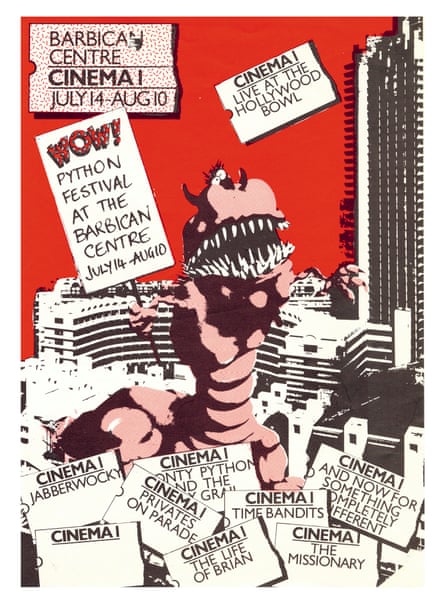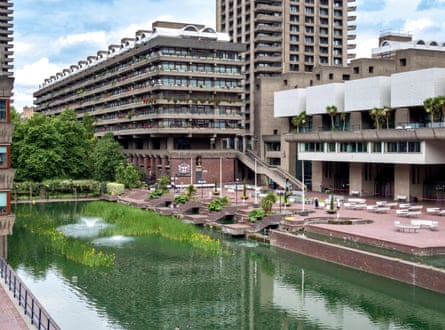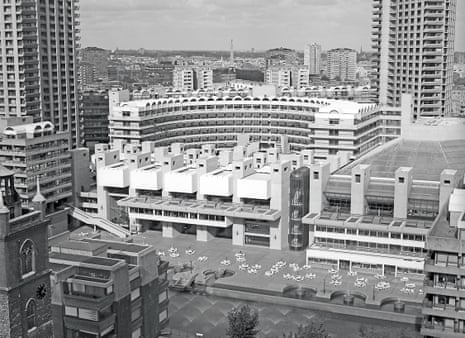It looks like something from a wildly imaginative sci-fi comic, an impossible vision of worlds slamming into each other in a fantastical collage. Elevated walkways leap across the sky while a trio of towers rise up like serrated blades, their edges sawing at the clouds. Beneath them, fountains cascade and cafes spill across lush waterside terraces, while an art gallery and library jut out overhead. A tropical conservatory wraps around the top of a subterranean theatre, next to a cinema buried beneath a crescent of apartments. And the entire multilayered edifice floats above a 2,000-seat concert hall carved into the ground.
This is no sci-fi comic, but a cutaway diagram of the Barbican arts centre dating from 1982, rendered in vivid orange, red and green. Somehow, this miraculous Escher-like wonder really did get built, and it hits 40 this month, with celebratory events and a handsome new book modestly titled Building Utopia.
As well as charting the last four decades of performances, exhibitions and events staged in the bowels of this brutalist behemoth, the book sheds light on the battles that were fought to realise the entire Barbican project, not just its world-class arts centre. We learn about its long struggle for acceptance – and the intractable quirks that have plagued the development since opening. “It took more than a generation and a half to be constructed,” recalls Frank Woods, an architect who worked on the project, “another generation to be absorbed into the culture of the City and another to be regarded as an international model of its kind.” For some, this is a battle still to be won.

The idea for the Barbican was driven by the need to save the Corporation of London from oblivion after the second world war had devastated the residential population of the Square Mile. By 1951, Cripplegate had a population of just 48 – a century earlier, it had been home to 14,000. Without residents and voters, the City faced losing its centuries-old powers and being absorbed into the wider London County Council.
Imagined as a “city within a city”, the Barbican was concocted to lure well-heeled middle-class professionals into the centre, providing a utopian community for 4,000 residents, with unparalleled cultural facilities on tap, along with schools, a church, shops and pubs, all arranged around an artificial lake. The raw concrete look of the estate has led many to believe it was originally built as social housing, but it was nothing of the sort. The flats were designed to be high density and high value, to help pay for the vast cultural podium on which they stood. The arts centre – which trebled in size during the design process – would be buried, so as not to obstruct the view from the luxury apartments.
An essay in the book by Elain Harwood, postwar specialist at Historic England, unpicks the evolution of the scheme, by the young architecture firm Chamberlin, Powell & Bon. “We strongly dislike the Garden City tradition,” the architects declared, “with its low density, monotony and waste of good country, road, kerbs, borders and paths in endless strips everywhere.” Instead, they wanted to make a “truly urban” place, inspired by their visit to Le Corbusier’s Unité d’Habitation in Marseille. Harwood notes how they also drew on historical references, from the stark medieval towers of San Gimignano in Italy to the repeated barrel-arched roofs of the churches on the Greek island of Mykonos. The brick used at the lowest levels was a nod to the warehouse basements that had stood there until hit by Luftwaffe bombs.
The result was a beguiling cocktail – part bastion, part brutalist hanging gardens of Babylon – and it stood as the ultimate expression of the modern movement’s search for a monument. As the Architects’ Journal put it: “The Barbican, now it is completed, has all the aspects – gigantisms, singleness of purpose – of that bygone age when architects had the confidence (or naivety) to believe that monumentality had a place in architecture – and that part of their job was the imposition of discipline and order on the users of the buildings.”

By the time it was finally finished in the 1980s, such modernist dogma was anathema. Massively delayed and hugely over budget, the Barbican was seen by many as a concrete albatross around the City’s neck. In one heated, high-level debate, a city official argued that the money would have been better spent on prisons. The Aberdeen Press and Journal’s review was typical of the reaction to the opening in 1982: “From the outside, the much-publicised Barbican Centre hardly looks like £152m worth” – a figure that would be almost £600m in today’s money.
Once inside, however, the reviewer was won over. “The overpowering imagination, skill and effort which has gone into the 25-year project becomes apparent immediately. It is engrained in the pine-clad walls, the polished teak flooring, the subtle lighting, the overall design. In fact, the Barbican has been described as ‘a haven of cultural perfection in the midst of the City of London.’”
Christoph Bon, the Swiss architect of the trio, had been adamant that fixtures and fittings in the public areas should be as luxurious as possible. As a result, visitors glide over end-grain wood-block flooring, run their fingers along polished brass handrails and lounge inside the Peruvian walnut cocoon of the theatre – materials all chosen to contrast with the artfully rugged surface of the pick-hammered concrete walls. There were innovations at every turn, like the fact that each row of theatre seating had its very own door – a boon for latecomers trying to sneak to their seats.
And latecomers did not always have themselves to blame. The complexity of incorporating so many venues on so many levels across a 40-acre site has always made the place an infuriating labyrinth for the uninitiated, with successive decades of signage and way-finding strategies deployed in an attempt to ease the maze-like passageways. Even before the arts centre opened, it had garnered a reputation as impossibly difficult to navigate. One official advertising poster even quipped: “If Helen Mirren can find the new Barbican Centre before it opens in March, she will be appearing there in A Midsummer Night’s Dream.”

While not shying away from the Barbican’s more dysfunctional sides, the book contains some eye-opening recollections from those who have had to endure its back-of-house areas, including actor Fiona Shaw, who arrived when the Royal Shakespeare Company’s tenure here was only two seasons old. “Its early reputation among the RSC actors was as a very luxurious but terrifying building,” she writes, describing how the stage door was “hidden like an afterthought”, and how actors spent their time “lost on the staircases and the inhospitable corridors”, forced to rehearse in underground rooms “like canaries in a mine”.
Some of these enduring idiosyncrasies are part of the reason why the Barbican recently launched a £150m architectural competition, to seek “a new vision for a global icon”. Fans of the place have good reason to be wary. There have been many past attempts to tame the beast, most of which have come a cropper. In the early 1990s, Theo Crosby of Pentagram was charged with creating a new look for the centre, which introduced pastel colours and gilded fibreglass statues in a bizarre whimsical pastiche – derided as “feeble tinkering” by Geoffrey Powell, one of the original trio.
Gillian Darley’s review in the Observer was damning: “Crosby’s peculiar attempts to jolly up the Barbican suggest a damp squib of a student project rather than a scheme drawn up by an international design group.” Another rebranding project in 2000 prompted the Guardian to note: “The world’s most bewildering arts centre is solving the problem of its notorious signs once and for all – by getting rid of most of them.”
But this latest venture rings louder alarm bells still. While admirably aiming to improve the accessibility and sustainability of the complex, the brief also talks of “a huge opportunity to bring currently under-utilised spaces to life … in support of our creative and commercial ambitions”. It sounds suspiciously like a euphemism for turning it into a mall. The shortlist of architects charged with coming up with “bold” and “radical” solutions includes David Adjaye, Bjarke Ingels and Diller Scofidio + Renfro, a starry cast known neither for their subtlety nor their sensitive restorations of postwar buildings.
The Barbican may be a great hulking brute, but it is a carefully composed, grade II-listed one. It demands delicate intervention with a lightness of touch – not more shops squeezed into every available cranny.

Comments (…)
Sign in or create your Guardian account to join the discussion